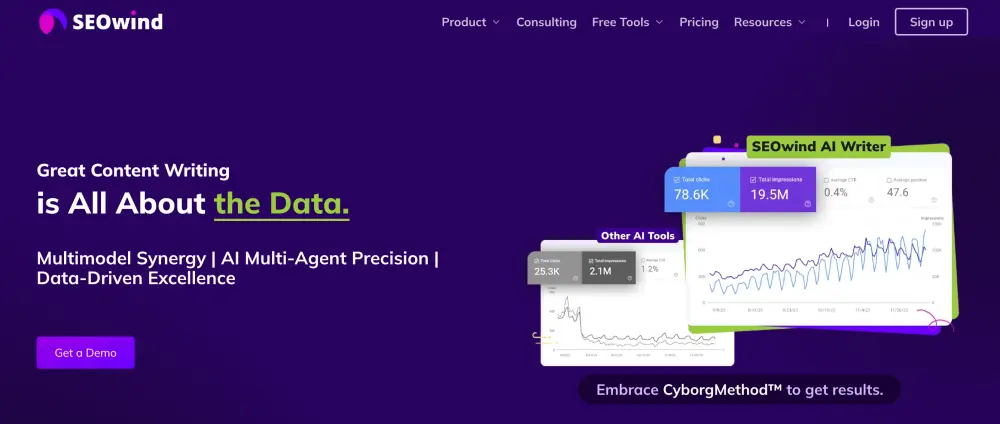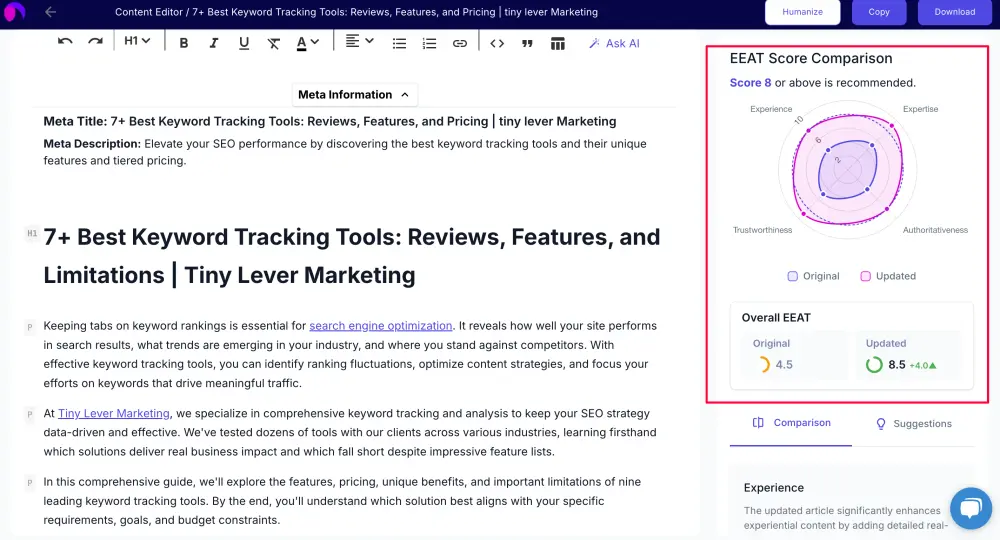SEOwind Review: I Let 3 AI Models Write the Same Blog Post—Here’s What Happened

Oussama Bettaieb
Marketing Director

Share to AI
Ask AI to summarize and analyze this article. Click any AI platform below to open with a pre-filled prompt.
So, I did a thing. I gave the same keyword—“digital marketing agency for small businesses”—to three different AI models using SEOwind, and let them battle it out for blog supremacy.
The goal? See if SEOwind can deliver “70-80% done” content —and figure out which AI model (GPT-4o, Claude 3.7, or Gemini 1.5) delivers the best draft.
This wasn’t some theoretical test. I created content, shared the outputs with our editor, and ran each piece through SEO and AI detection tools. No interference. Just data.
Let’s break it down.
🧠 But First… What is SEOwind?
SEOwind is an AI-powered content platform designed to:
- Build outlines and briefs using SERP analysis
- Generate SEO-focused blog content
- Suggest internal links (if you connect Google Search Console)
- Support content updates and rewrites
- Let you choose between three LLMs: GPT-4o, Claude 3.7, and Gemini 1.5
- Humanize AI content to make it feel less… AI
SEOwind has the potential to become your AI content assistant.
⚙️ Let’s Start with Setting Up a Project in SEOwind
Getting started takes less than 5 minutes:
Create a project – Add your brand name and URL.
Auto-filled brand info – SEOwind pulls in company details from your site.
Choose your AI model – GPT-4o, Claude 3.7, or Gemini 1.5 (no pricing difference).
(Optional) Connect Search Console – Useful for smarter internal linking.
Set brand voice – Provide a few lines or let SEOwind generate one for you.
Once that’s done, you’re ready to generate briefs or optimize content without touching a blank page.
🧪 My Test Setup
I created a test project for our internal agency brand, “Tiny Lever Marketing,” and did the following:
Used the same keyword and project setup across all three runs (I just had to change the model with every run)
Let SEOwind generate the full brief and draft (no outline changes, just one insight added: “Position Tiny Lever as a top agency for SMBs”)
Measured the outputs across:
- AI detection score
- SEO score
- Word count
- Editor usability
All models were tested using the same parameters. No editing, no tweaking. Just raw AI output.
🤖 A Quick detour, The Model Face-Off
Why I was interested in this?
Recently, we ran a test to see which LLM model gives the best output. We found that Claude Sonnet 3.5 had the most human-like content of all the tests we ran.
So know, given the opportunity, I wanted to run the test and see. Here are the results:
1. GPT-4o
- AI Score: 58.51%
- SEO Score: 45/100
- Word Count: 2,998 (800+ over target)
- Vibe: Balanced. Solid copy and decent structure, but needed a human pass to tighten tone and flow.
2. Gemini 1.5
- AI Score: 42.89% (lowest)
- SEO Score: 45/100 (tied)
- Word Count: Slightly under target (~2,100 words)
- Vibe: Felt a bit flat. Readable, but safe and formulaic—like a college student playing it too safe on an essay.
3. Claude 3.7 (Anthropic)
- AI Score: 63.63% (highest)
- SEO Score: 57/100 (also highest)
- Word Count: 5,900 (!)
- Vibe: Total overachiever. Impressive SEO logic, lots of detail, but 3X the word count. It definitely needed trimming, but it had strong bones.
🔧 Features That Stood Out
✅ One-Click Briefs
You plug in a keyword, and SEOwind builds a full brief with:
- Recommended H2s and H3s
- Media/image suggestions
- “People Also Ask” from Google, Quora, Reddit
- Meta title + description
- Competitor structure comparisons
- Secondary keyword suggestions
- Internal linking recommendations (if Search Console is connected)
You can even export it as a doc or edit directly inside SEOwind.
⚠️ The only annoyance? Editing H2s/H3s sometimes glitches. You’ll need to refresh the page to fix it.
✅ “Humanize” Mode
This was surprisingly good. I assumed it was just for dodging AI detectors—but it actually made the copy feel more natural.
I passed both the raw and humanized versions to our editor. The verdict?
The humanized draft was “one hour away from publish-ready.”
That’s a massive time-saver.
✅ Content Update Tool
You can plug in an old blog post, assign a new focus keyword, and SEOwind:
- Evaluates the current page based on E-E-A-T principles
- Rewrites or enhances it section-by-section
- Explains why it made certain changes (huge plus for editors)
- Offers suggestions to improve authority and trust
The first test overwritten too much. But when I added specific instructions like “keep the intro and structure,” it adapted based on competition and rewrote exactly how I’d expect a human to.

📈 Other Observations
- SEOwind’s E-E-A-T scoring helps you understand why something might not rank. Each draft gets a transparent score and suggestions.
- Although none of the outputs are publish-ready, they’re around 60–80% done—a massive jumpstart for any editor or content ops team.
- There’s no pricing difference between LLMs. Use GPT-4o, Claude, or Gemini as you like.
🟢 What I Liked
✅ All-in-one content workflow: from SERP analysis to article draft
✅ Excellent briefing system—especially for teams with junior writers
✅ Multiple LLMs at no extra cost
✅ EEAT scoring and suggestions to improve
✅ Humanizer tool that actually works
✅ Great for updating old content with clear, explainable logic
🔴 What Could Be Better
❌ Brief editor is buggy when reordering headings
❌ Word count overshooting (Claude went from 2,200 → 5,900 words, thought that’s mainly on the LLM model itself, I assume)
❌ Still needs a human editor to polish and fact-check
❌ No real-time collaboration (yet)—you’re editing solo in the tool
🧾 Final Verdict
SEOwind won’t replace your content writers—but it will make their jobs easier and faster.
It’s ideal for marketers and agencies looking to:
- Build briefs quickly
- Generate AI drafts that are SEO-aligned
- Streamline content updates
- Test different models without having to switch tools
It doesn’t give you a silver bullet—but it gives you a great head start. If you’ve got a clear editorial workflow and a human editor in the loop, SEOwind can take you from zero to 70% faster than most tools I’ve used.
Would I publish a raw draft from SEOwind?
🟥 No.
Would I use it to scale content smartly and save editing hours?
🟩 Absolutely.
TL;DR:
SEOwind is your AI-powered content assistant, not your ghostwriter.
Use it to generate smarter drafts faster. Then, pass it to your team to make it shine.